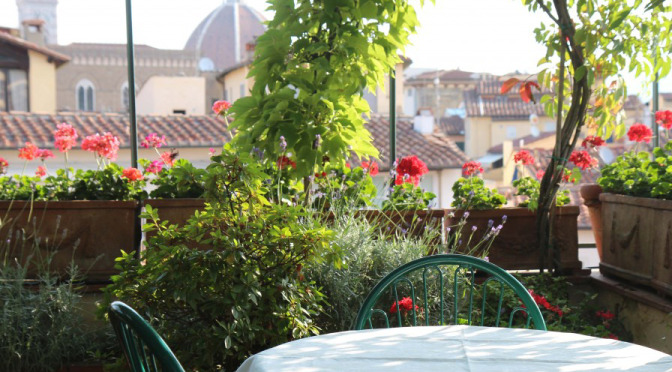June 24th, 12:52 PM
Roof garden shade: scent
Jasmine, lavender. The view
Ancient and modern.
Today is a traveling day and the day we will take the train and finally arrive in Reggio Emilia. Already packed and checked out I sit in the rooftop garden of our hotel waiting to meet everyone to go catch the train. I look out onto terra cotta roofs, the occasional medieval tower juts out between stucco modern day buildings. Chimneys, some stucco and some gleaming new stainless steal; hot water tanks, TV antennas, and satellite dish receivers dot the roofs. Some small porches with potted plants and a few with laundry drying can also be seen. Beyond the city, I can see the Green Tuscan hillside, dotted with Cypress trees and hear the birds everywhere. The Duomo, the dome of the main cathedral is very close and even closer is the tower of the Palazzo Vecchio, not more than a soccer field away. Last night as we walked back from dinner through narrow stone paved alleyways we heard the Brazilian soccer fans roar when their team scored a goal in a World Cup game.
The sense of time in Italy is different: one can feel the deep roots of the people and the history that stretches out behind them. Roman ruins found beneath churches, foundations of medieval bridges are found under current spans. This is a place that relates to its history — cannot avoid it, in all its churches, in its many apartment buildings that are former palaces, in the hordes of tourists who come to see its riches. Today is St. Johns Day, the day of the patron saint of Florence. From time to time the bells ring with a certain festival urgency, and I can hear a choir singing in an adjacent church. When I was out earlier, a Renaissance procession, with drummers, horn players and singers passed through the streets.
There were women dressed as ladies in waiting, and men in the red and white, blue and yellow, red and black, yellow and white, garb of soldiers, guards, princes and nobleman. Some carried flags. Their costumes were complete and accurate, from the distinctive hats, down to the different colored leggings (one red, one black, or some other pair, depending on the costume). Even their shoes had the same Mary Jane style and droplet shaped decorations at the toe – each of the costumes had a shoe that was colored to suit.
I looked closely at the people wearing the costumes and being the procession: these are real people who maintain this tradition, presumably year after year. Only the youths in their teens and twenties had new shoes – the older men had clearly made this trek around the city streets before; just as others for generations have done this before them. Their faces ceremonial, for the most part, they maintained a slow cadence, stepping as the drums beat. I caught a couple of the older men ¾’s of the way back as they shared a joke with one another.
Perhaps this sense of history and tradition provides the people with a different relationship to time. They have more respect for it, and more acceptance of it. They seem to have more patience, more trust in the process and perhaps this is what has influenced the Reggio approach to the learning of young children more than any decision or ideology might have created. And at the same time, they also embody the juxtaposition of old and current in the constant active design of the facilities and equipment, deep listening to the children, and staying abreast of their concerns, interests and passions.

